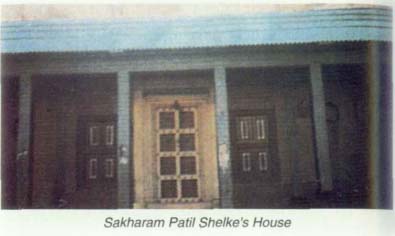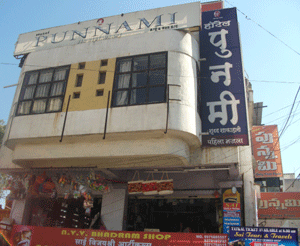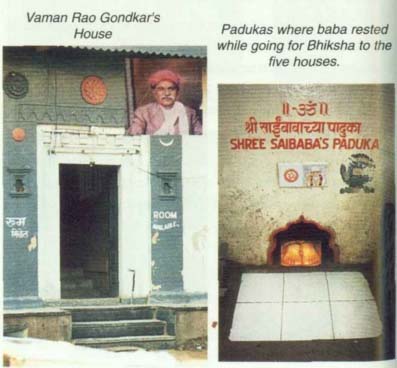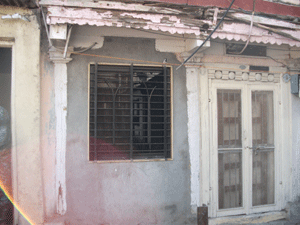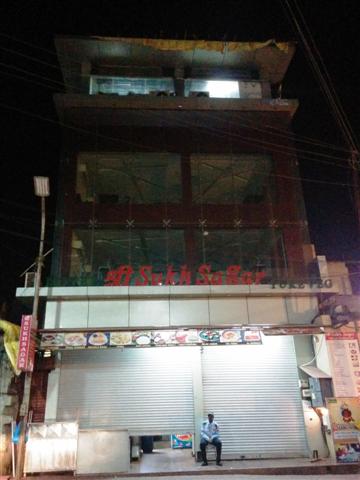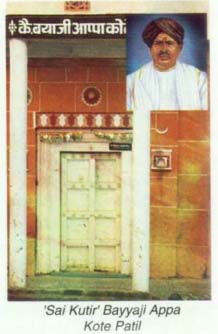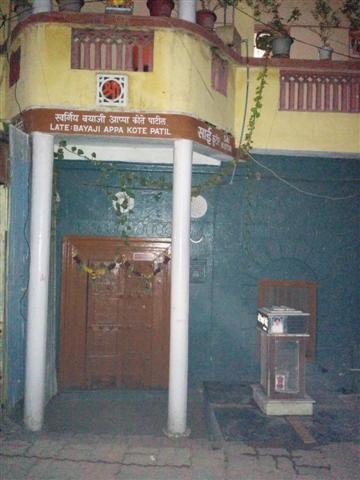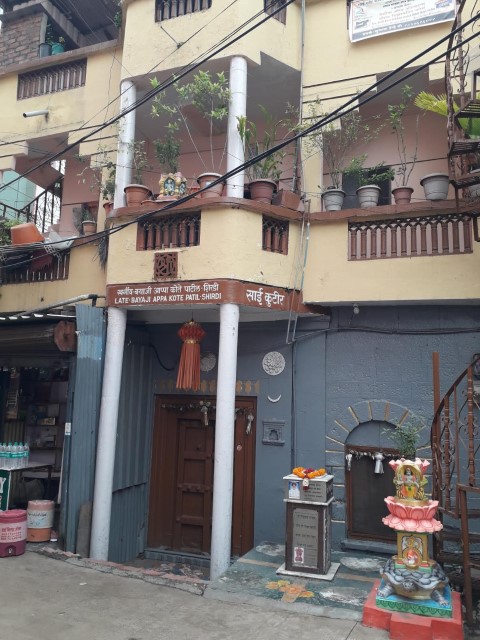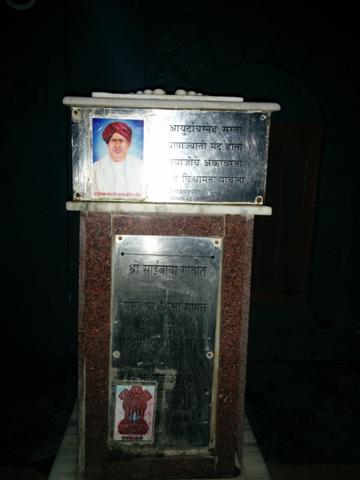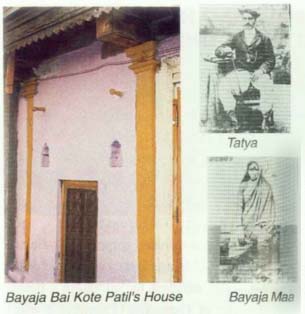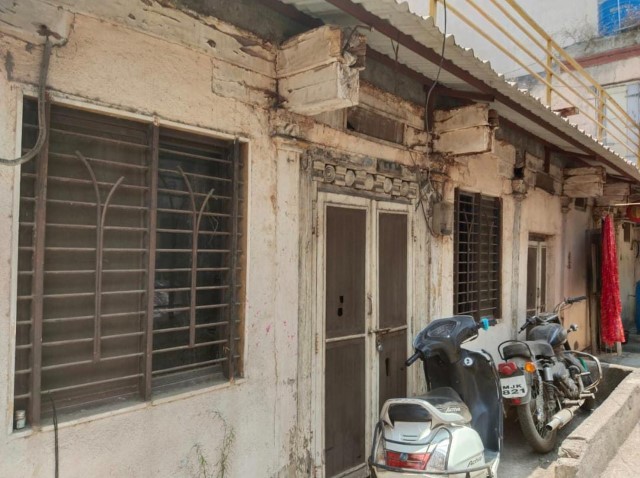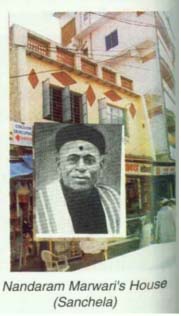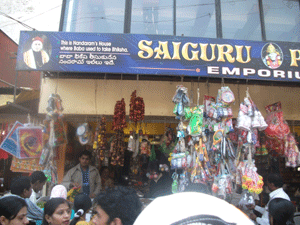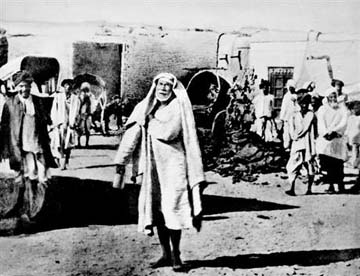FIVE BLESSED HOUSES THAT BABA TOOK BHIKSHA FROM
|
This house is near Baba's Chavadi with a west facing entrance. Sakharam was a farmer, a wealthy landlord, and was devoted to Baba. Sakara Bai the wife of his grandson, Hari Bau, states that Baba loved Sakharam very much. Baba would stand at the crossroad between Vaman Rao Gondkar's house and Shelke's house and call out "Sakharam Roti de". She also stated that his son Triambak (Hari Bhau’s father) donated some land to Baba's Sansthan. The land for the Shirdi Bus Stand was donated by him. Triambak's Samadhi is inside the compound of the Narasimha Temple which is adjacent to Sakharam's house. The other two Samadhis are of Thana Bai (Triambak's wife), and Ramgir Bua whose name is mentioned in Sri Sai Satcharitra Chapter 33. There were many Gosavis living in Shirdi at that time, and their samadhis are in the same compound. Unfortunately, their names are not known.
The Narasimha Temple was constructed by the Shelke family. Narasimha is the Kul Devata of the family. A priest performs puja daily along with Aarti and offers Bhog. Around the year 2000, this house was sold by his descendants, and a multi-storey shopping complex now stands in its place. The location link is as follows: https://maps.app.goo.gl/qU7dYyAivuitKmqt5
This house is on the right hand side opposite to Sakharam Shelke's house. Vaman Rao was born and bred in Shirdi. His family was wealthy farmers and landowners. His descendants say that they owned 500 acres of land in and around Shirdi. They also state that they owned Lendi Baugh and adjacent lands. They sold Lendi Baugh to Moreshwar Pradhan who donated it to the Sansthan. This is one of the blessed houses that Baba took Bhiksha from. Mention is made of this house in Sri Sai Satcharitra Chapter 19. Baba placed a ladder against this house and climbed up on the roof. Then he crossed the roof of Radhakrishna Mai's house and descended on the rear side. At that time Baba was very sick and so was Radha Krishna Mai. Purandare had pleaded with Baba to cure Mai and this was Baba’s unique remedy. Baba gave Rs.2/- to Venku Kamblekar, who brought the ladder, for his labour. The other devotees objected saying that Baba had paid too much. Baba told them that any labour should be paid for promptly and adequately. Kamblekar had no children but after he received this money he prospered and got two sons. Vaman Rao Gondkar after leading a prosperous life died on 15th April 1964. His descendants are living in Shirdi and carrying on his legacy. The Palkhi and Rath when taken in procession through the village on festivals, stops first at this house. The family is given the honor of doing the first pooja to Baba and the Palkhi and Rath.
In the year 2014, this house was sold by his descendants, and a Hotel now stands in its place.
Bayyaji Appa Kote Patil’s House (SAI KUTIR) His house is named “Sai Kutir” and is at the end of Kote Gully. He was born in Shirdi and was close to Baba since infancy as his father was a staunch devotee. He started serving Baba at the age of eleven. Bayyaji Appa Kote Patil was a land owner, revenue and police patel of Birgoan. He was very affluent and owned 84 acres of land. He states that Baba took Bhiksha from his house many times up to His Mahasamadhi. Bayyaji noted that Baba was very fair and just and would enjoin silence on the Hindus when Namaz was being performed and vice versa. Sweets and Pedas were distributed to all alike. Baba forewarned him of his father's death, which later happened as Baba had predicted. Baba used to give him Rs.4/- daily and said "Do not eat and excrete". So he invested it in land and had 84 acres. Baba also advised him what to cultivate on it, and He was always right. Once he did not heed to Baba’s advice, and there was no yield and he incurred a loss of 300 rupees. He was with Baba when his Mahasamadhi occurred. Baba distinctly told him "I am leaving, carry me to the Wada. All Brahmins will be living near me." With these words He took Mahasamadhi. Baba was sitting when he breathed his last. Nana Saheb Nimonkar poured some water by placing his cupped palm below Baba’s chin. Baba leaned on him and took Samadhi. His descendant Gopinath Kote still lives in that very house. The Shirdi Saibaba Sansthan has given that family the honor of carrying Baba’s Padukas (holy footwear) and Satka (Baton) for the Chavadi procession. The location link to Bayyaji Appa Kote Patil is as follows: https://goo.gl/maps/feLBjD7fjLphUXu66
Bayaja Bai Ganapath Kote Patil’s House (BAYAJA MAA) This house is situated adjacent to “Sai Kutir”. Bayaja Maa came to Shirdi after she married an affluent landowner, Ganapath Kote Patil. She was a dutiful, loving wife, who did all the household chores. But most of all she loved to cook and feed various guests and relatives that came to her home. “Food is Brahma” she knew and was the first lady to feed Baba when he came to Shirdi in the early days. In Chapter 8 of the Sri Sai Satcharitra her love, devotion and caring is beautifully described. Bayaja Maa recognizing His divinity would roam about in search of the Fakir and feed Him daily. She then returned home to eat. Her trouble ended when Baba came to live in the Dwarakamai Masjid. Daily Baba took Biksha from her house. As soon as she heard Baba’s voice she left whatever she was doing. Whether it was attending to the cattle or horses went inside and prepared fresh Bhakri and curried vegetables for him. Baba was very pleased with her love and devotion. Baba asked her once what she wanted? "Do you want Sampathi (wealth) or Santhathi (welfare of your family)"? Unhesitatingly she asked for the welfare of Tatya, who had no children, though he had three wives. True to His promise Baba looked after Tatya and his family, and even took 'niryan' for him. When Baba was in his physical form, Aarti was performed to him. Usually during Madhav Adkar’s Aarti “Aarti Sai Baba Sowkya Dathaara Jeeva” he was offered the Chillim. Baba would take a puff or two and then pass it around. The Shirdi Saibaba Sansthan has bestowed the honor of carrying Baba’s photograph during the Palkhi procession on their descendants. The details of Chavadi Procession are as follows: Viju Kote Patil who is Tatya’s grandson and Gopinath Kote who is Bayyaji’s grandson goes to the Samadhi Mandir just before the Palkhi procession commences. The Pujari gives Baba’s photograph to Viju and the case containing the Padukas to Gopinath. (Earlier, they would ascend the steps of the Samadhi to pick them up. But this process has been stopped about four years ago). They then carry them to the waiting Palkhi and place them inside. Then the Palkhi proceeds to the Dwarakamai. Viju then takes Baba’s photograph and places it on the stone for a short while. After Baba has sat on the stone for sometime, he’s taken to the sanctum sanctorum. The photograph is then placed in the Mandap for sometime. Then it is brought to the Palkhi and placed in it. Until Viju signals to the Palkhi bearers to lift the Palkhi, it is not lifted. Just as Baba would not get up until Tatya came and lifted him and asked him to go for the Palkhi procession. The Palkhi then goes to the Chavadi, and Aarti is performed there. At that time Baba is offered a lighted Chillim by Viju. The location link to Bayaja Bai house is as follows: https://goo.gl/maps/ToKa3xrfoHMocdCt8
Nandaram Marwari Sanklecha’s House Nandaram was a rich landowner and moneylender by profession. But he was kindhearted and a gentle person. His grandfather came to Shirdi from Rajasthan (Kharade village) and Nandaram was born in 1866 and grew up in Shirdi. He came close to Baba in 1875, and his devotion increased by leaps and bounds. In fact, he spent most of his time with Baba. Nandaram's house was one of the five blessed houses that Baba took Biksha from. It is said that Baba would visit this house last although it was very near to the Dwarakamai, almost in front of it. Baba loved this family and He would call out to Nandaram's wife Radhabai who had a speech problem. Baba would say "Oh, Bhopadi Bai, Biksha de". If she was late in offering Biksha He would shower abuses on her and return to the Dwarakamai. Baba sometimes asked her to make Puran Polis (Wheat chapathis filled with sweet stuffing of Channa Dal) and a full meal. After making all the preparations she would take the thali to the Dwarakamai, but Baba would eat very little and distribute the rest. Radhabai was devoted to Baba. She knew Baba’s abuses were blessings in disguise. Every Diwali she got five yards of white Manjarpat (coarse cotton) and stitched a Kafni for Baba, and presented it to him. Baba wore it immediately with great joy and happiness. In 1911 when plague was rampant in Shirdi the villagers quickly started fleeing. Nandaram met some of the villagers who remarked that his eyes were red with fever and that was the first sign of the plague. He was startled to hear this and went on horseback to take Baba's permission to leave and go to his village Ekruka. Baba dissuaded him from leaving. He assured Him that he was not going to die. "I will not let you die till I die" and gave him Udi and he recovered. On another occasion there was a terrible sickness, and many villagers were seriously ill with it. It was believed that sugar was not to be ingested during the illness. Those who did ingest sugar were gravely sick and some lost their lives. Nandaram was also afflicted with the disease. When he noticed the first signs of the disease, he went straight to the Dwarakamai and sought refuge at Baba’s feet. Baba took out a packet of sugar from his pocket and gave it to him. Nandaram had utmost faith in Baba, so he at it at once and recovered. Nandaram's grandmother asked Baba to look after her family, as the male children died in infancy. Baba gave her three mangoes and she got three sons. After this “Aam leela” all the male children survived. The best deed that Nandaram did was to donate the land that was between Butti Wada and Dwarakamai for Baba's use. This deed was done through Damu Anna and hence the Samadhi Mandir was extended. Nandaram believed in doing good, in giving rather than receiving. He also repaired and made the flooring of Maruti and Ganesh temples. He died on 13th October 1946. His philanthrophic and social work is carried on by his descendants (As narrated by Nandaram’s grandson Dilip Sanklecha to the author).
A Commercial Complex has now come up in the place where Nandaram Marwari Sanklecha's house was present.
Location link to Nandaram Marwari's house is as follows: https://goo.gl/maps/WTxEG4eXyPNULJFU6 Saibaba Going for Bhiksha (Original Photograph) This original photograph shows Baba going for Bhiksha. The villagers would often bring their wares and set up temporary shops. Baba is seen in the vacant space near the Chavadi between Vaman Rao Gondkar’s house and Sakharam Shelke’s house. Baba is seen with the tumrel in his hand and a cloth over his head.
Saibaba’s Bhiksha Route Bayyaji Patil says Baba took Bhiksha from the beginning of his stay in Shirdi till the day of his Mahasamadhi. “Baba would go over eight times a day for about three years, next three years four times a day and for twelve years twice a day and during the last twelve years once a day” (Refer Devotee Experience of Saibaba). Bhiksha was a must, if he did not go he used depute someone instead like Vaman Rao Patel etc. In 1916, Prof.G.G.Narke states that he yearned to do this service when he went to see Baba. Baba sometimes suddenly said “Let this man go and beg for food with that bowl today”, thus fulfilling his inner most desire (Refer Devotee Experience of Saibaba). Baba started his Bhiksha rounds at about 8.00 a.m. He took Bhiksha from five selected houses. He would place a cloth on his head which when folded would assume the shape of a Joli. This was used for dry foods like Chapatti, Bhakri, Rice etc. In his right hand he carried a Tumrel for liquids. From the Dwarakamai Baba walked past the Chavadi and stood in between the houses of Sakharam Shelke and Vaman Rao Gondkar. These houses are opposite each other with a narrow lane in between. He stood at a fixed place and called out “Oh, Lassie, give me a piece of Bread”. From there he proceeded to Bayyaji’s House. During those days, on the way there was a hillock. Baba stood there for a while and fed the birds and dogs. In memory of this, Padukas were installed. These Padukas are now in the wall of Narasimha Lodge. There is a tiny Mandir enclosing them. The uniqueness of these Padukas is that they are not raised but engraved in the stone. In between the Padukas there is a water bowl. Later, road widening took place and these padukas had to be shifted. They were given by Shelke family to be established at the Sai Korhale Temple where they are at present.
Bayyaji and Tatya’s house are next to each other. After getting Bhiksha from there, he proceeded to Nandaram Marwari’s house. This was the fifth and the last house. He walked past Tajim Khan Baba’s Darga. It is said that he often went inside this building and then came to Nandaram’s house. After receiving Bhiksha there he returned to Dwarakamai Masjid. In the Masjid, he mixed the food together and kept it in the Kolamba for any and everyone to partake off it. |
(Source: Ambrosia in Shirdi & Baba’s Gurukul by Vinny Chitluri. Photo Courtesy: J.Subramanya, Bangalore and Shri.Pranav, Nirmal District, Telangana) |
|---|
